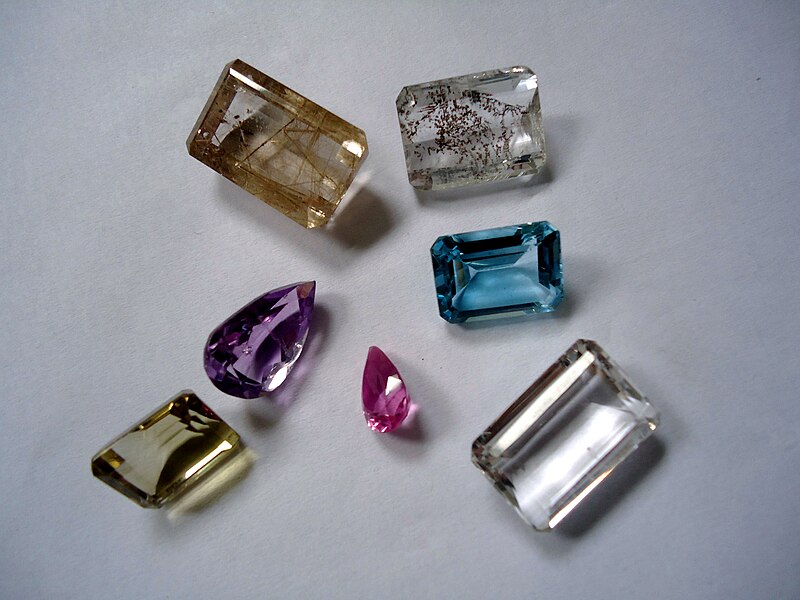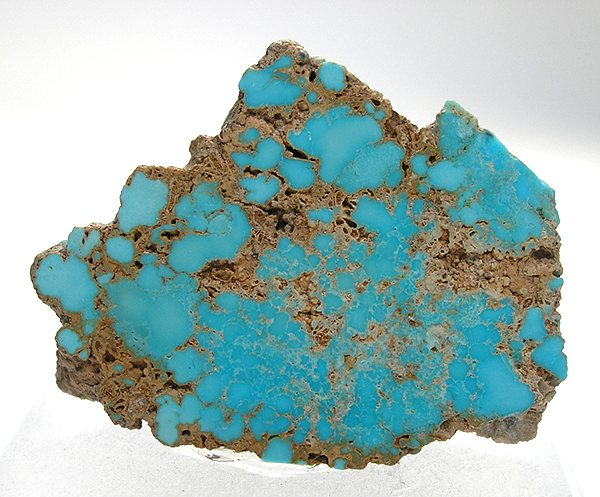 |
| Semi precious gemstones Photo by Mauro Cateb |
All gemstones are minerals, but not all minerals are
gemstones, so the limited knowledge imparted here can be used on both gemstones
and minerals. If you can’t tell what
kind of gems you own don’t feel bad because there have been plenty of emperors
and kings that didn’t have a clue about what kind of stones they had in their
own crown. A good example of this is the
Black Prince’s Ruby that resided in the Crown of England for hundreds of years
before somebody found out it was really a mineral called “spinel.”
This is a stone that looks like a ruby
but is a much less expensive stone then real ruby. Clear white topaz is often mistaken for diamond and in the past many
large diamonds have been found to be really topaz. Identifying these stones is in the realm of
the gemologist who is specially trained to
identify gemstones.
 |
| A translucent ruby Photo by Rob Lavinsky |
There are several stones that are treated as gemstones, but
aren’t. Amber is a glaring example of
this, a stone that is treated as a gem but in reality is fossilized tree sap
having many inclusions of insects and other organic matter. Petrified wood is another example that is
often beautiful and is treated by many as a gemstone, but isn’t. Jet, the black stone is actually a variety of
coal and far from the definition of a gemstone, as are pearls. Pearls have the distinction of being the most
valuable stone, but they aren’t gemstones either.
Identifying gemstones and minerals is really a process of
the elimination, for instance if you are presented with a green clear gemstone
it is not apt to a ruby. More than likely it is emerald, but you really can't
be sure without further tests. There is a variety of garnet called demantoid
that is also green and is often mistaken for an emerald. One of the most
important tests that are used in mineral identification is the color of the
stone.
Hardness
is another criterion that is used. This is based on the Moh’s hardness scale
that ranges from 1 to 10 with diamond being the hardest and soapstone the
softest. Most stones that are used in making jewelry are harder than seven on
the Moh’s scale even though some stones that are as soft as three on the Moh’s
scale are faceted for collectors. You can buy hardness testing kits or make
your own from various minerals that work’s as good as store bought.
 |
| Turquoise from Mojave County, California Photo by Rob Lavinsky |
The looks
of the stone are important is it transparent, translucent or opaque. Transparent means can you see through the
stone so things can be seen clearly that are behind the stone. Translucent means does light pass through the
stone, but you can’t make out objects that are in back of the stone. Opaque means light doesn’t pass through the
stone, and you can’t see through it.
Streak is literally a thin mark of the mineral or
gemstone composed of very fine powder left on a piece of unglazed porcelain
colored either black or white. Black is
often used to test for gold and other precious metals when it is known as a
“Touchstone.” It is often used in
conjunction with acid to see if there is a reaction between the streak and the
acid. The karat weight of gold can be
determined by treating its streak with various concentrations of nitric acid.
 |
| 2x2 inch black and white streak plates, White is pyrite and black is rhodochrosite |
We sell streak plates: Click Here
Cleavage
and fracture are other important tests.
Fracture is most important for quartz gemstones that break in a
Concoidal fracture that looks like little clam shells. Some minerals like jade have a hackly
fracture i.e. a rough appearance. Some
stones have a pronounced cleavage like topaz or diamond. Topaz is especially prone to a perfect basal .
cleavage causing it to be a poor gemstone.
Specific Gravity
was discovered by Archimedes
when he was tasked to find out if a gold smith cheated the Tyrant of Syracuse
when he was making a golden crown for the tyrant. This was a job that required quite a lot of
forelock tugging on the part of Archimedes until he finally threw his hands up
and decided to take a hot bath. His slave girl filled the bathtub to full of
hot water so on Archimedes claimed into the tub it overflowed. He had
discovered the principle of specific gravity, and with that he jumped out of
the bathtub and went streaking through the town agora of Syracuse
yelling at the passersby Eureka , Eureka
that means I have found it, I have found it. They all thought he had gone nuts,
and if it wasn't for the fact his brother-in-law was the tyrant he will
probably been slapped in jail.
What Archimedes discovered was the body would displace an
equal amount of water according to its volume, or in modern terms its weight
per cubic centimeter. This is normally taken by first weighing the object in air
and then weighing in water. The difference is its Specific Gravity.
 These are some simple tests that can
help with gemstone or mineral identification there are others that are far more
complicated that can be used in conjunction with the simple tests. Although
there are over 2000 recognized minerals in the world there are only about 300
that are common rock forming minerals that you are apt to encounter in the
field. A good source of information about most minerals can be found at www.mindat.org.
These are some simple tests that can
help with gemstone or mineral identification there are others that are far more
complicated that can be used in conjunction with the simple tests. Although
there are over 2000 recognized minerals in the world there are only about 300
that are common rock forming minerals that you are apt to encounter in the
field. A good source of information about most minerals can be found at www.mindat.org.
Hi admin,
ReplyDeleteYour giving information is very useful.Thanks for sharing information about gemstone. For more detail click this hyper link:Precious Gemstones
Very great post.Thanks for sharing this post.
ReplyDeleteBuy Amethyst Gemstone (Jamunia) online at best price Amethyst Gemstone online at the best price. Shop our collection of high-quality gemstones with the best price and make your purchase with confidence today.